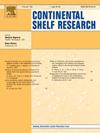Determining the cross-shelf and vertical scales of coastal upwelling
IF 2.1
3区 地球科学
Q2 OCEANOGRAPHY
引用次数: 0
Abstract
Idealized primitive equation numerical model experiments are used to investigate the source waters (as defined by a passive tracer of initial depth) for coastal upwelling over a uniformly sloping bottom and allowing for alongshore variability in the wind stress. Under steady conditions, the volume of upwelled water is essentially balanced by alongshore transport from the direction (“downwave”) toward which long coastal-trapped waves propagate. For weak stratification (s = αN/f ≪ 0.1 where α is the bottom slope, N the initial buoyancy frequency and f the Coriolis parameter) this alongshore transport involves a balance of bottom Ekman pumping and topographic vortex stretching: the “arrested topographic wave”. For larger s, some of this alongshore transport occurs in a frontal jet. When time dependence is included, a third offshore scale, determined by frontal motion balancing local Ekman transport, enters initially, while the frontal equilibrium scale dominates after longer times. The offshore scale translates readily into a maximum depth from which upwelled waters can reach the surface. Scalings are provided for the source water depth in both the steady and unsteady cases. Broadly speaking, the source depth is greater when alongshore winds or bottom slope are stronger, or when the alongshore extent of wind forcing is greater. Some variants, including the effects of a more realistic shelf-slope topography, are also examined.
确定沿岸上升流的跨大陆架尺度和垂直尺度
在沿岸风应力沿岸变化的情况下,利用理想化的原始方程数值模式实验,研究了均匀坡 底沿岸上升流的源水(由初始深度的被动示踪剂确定)。在稳定条件下,上涌的水量基本上由沿岸长波传播方向("下行波")的沿岸输 送来平衡。在弱分层条件下(s = αN/f ≪ 0.1,其中 α 为底部坡度,N 为初始浮力频率,f 为科里奥利参数),这种沿岸输送包括底部埃克曼泵送和地形涡旋拉伸的平衡:即 "受阻地形波"。当 s 较大时,部分沿岸传输发生在锋面喷流中。如果将时间依赖性考虑在内,最初会出现第三个离岸尺度,该尺度由锋面运动平衡局部埃克曼输送决定,而锋面平衡尺度则在较长时间后占主导地位。离岸尺度很容易转化为上涌海水到达地表的最大深度。提供了稳定和非稳定情况下源水深度的刻度。一般来说,当沿岸风或底坡较强时,或风力作用的沿岸范围较大时,源水深度较大。此外,还研究了一些变异情况,包括更现实的陆架-斜坡地形的影响。
本文章由计算机程序翻译,如有差异,请以英文原文为准。
求助全文
约1分钟内获得全文
求助全文
来源期刊

Continental Shelf Research
地学-海洋学
CiteScore
4.30
自引率
4.30%
发文量
136
审稿时长
6.1 months
期刊介绍:
Continental Shelf Research publishes articles dealing with the biological, chemical, geological and physical oceanography of the shallow marine environment, from coastal and estuarine waters out to the shelf break. The continental shelf is a critical environment within the land-ocean continuum, and many processes, functions and problems in the continental shelf are driven by terrestrial inputs transported through the rivers and estuaries to the coastal and continental shelf areas. Manuscripts that deal with these topics must make a clear link to the continental shelf. Examples of research areas include:
Physical sedimentology and geomorphology
Geochemistry of the coastal ocean (inorganic and organic)
Marine environment and anthropogenic effects
Interaction of physical dynamics with natural and manmade shoreline features
Benthic, phytoplankton and zooplankton ecology
Coastal water and sediment quality, and ecosystem health
Benthic-pelagic coupling (physical and biogeochemical)
Interactions between physical dynamics (waves, currents, mixing, etc.) and biogeochemical cycles
Estuarine, coastal and shelf sea modelling and process studies.
 求助内容:
求助内容: 应助结果提醒方式:
应助结果提醒方式:


